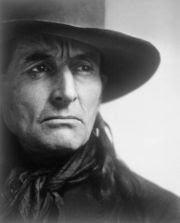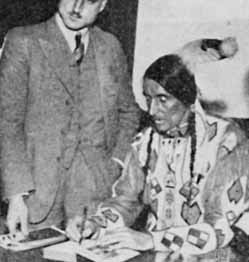
Grey Owl (in Ojibwe: Wa-sha-quon-asin) was the name Archibald Belaney (September 18, 1888 – April 13, 1938) adopted when he took upon a First Nations identity as an adult. He was a writer and became one of Canada's first conservationists.
 Archibald Stansfeld Belaney was born in September 1888 in Hastings, England, to a farmer family. His father wasted the family fortune in drinking. Some sources also suggest that his mother was only 13 years old when they were married. His parents separated in 1901, and his father left the country.
Archibald Stansfeld Belaney was born in September 1888 in Hastings, England, to a farmer family. His father wasted the family fortune in drinking. Some sources also suggest that his mother was only 13 years old when they were married. His parents separated in 1901, and his father left the country.
Belaney was raised by his grandmother and two maiden aunts. He expressed an interest in nature and American Indians at an early age. He went to Hastings Grammar School, and at the age of 16 – due to his aunts' urging – left to work for a timber yard. He was fired when he dropped a bomb down his employer's chimney.
 Archibald Stansfeld Belaney was born in September 1888 in Hastings, England, to a farmer family. His father wasted the family fortune in drinking. Some sources also suggest that his mother was only 13 years old when they were married. His parents separated in 1901, and his father left the country.
Archibald Stansfeld Belaney was born in September 1888 in Hastings, England, to a farmer family. His father wasted the family fortune in drinking. Some sources also suggest that his mother was only 13 years old when they were married. His parents separated in 1901, and his father left the country.Belaney was raised by his grandmother and two maiden aunts. He expressed an interest in nature and American Indians at an early age. He went to Hastings Grammar School, and at the age of 16 – due to his aunts' urging – left to work for a timber yard. He was fired when he dropped a bomb down his employer's chimney.
 In 1906 Belaney emigrated to Canada, ostensibly to study agriculture. After a brief time in Toronto, he moved to Temagami, Northern Ontario, and adopted an Indian identity and the name Grey Owl. He also married an Anishinaabe woman, Angele Egwuna. He worked as a fur trapper, wilderness guide and forest ranger. He explained that he was a child of a Scottish father and Apache mother and had emigrated from the US to join the Ojibwa.
In 1906 Belaney emigrated to Canada, ostensibly to study agriculture. After a brief time in Toronto, he moved to Temagami, Northern Ontario, and adopted an Indian identity and the name Grey Owl. He also married an Anishinaabe woman, Angele Egwuna. He worked as a fur trapper, wilderness guide and forest ranger. He explained that he was a child of a Scottish father and Apache mother and had emigrated from the US to join the Ojibwa.During World War I, in 1915, Grey Owl joined the 13th Montreal Battalion of the Black Watch. His unit was shipped to France, where he served as a sniper. His compatriots treated him as an Indian and generally praised his conduct afterwards.
 He was wounded first in January 1916 and then again on April 24, 1916 with a shot through the foot. The wound contracted gangrene, and he was shipped to England for treatment.
He was wounded first in January 1916 and then again on April 24, 1916 with a shot through the foot. The wound contracted gangrene, and he was shipped to England for treatment.In 1925 he met the Iroquois woman Gertrude Bernard (whom he later called Anahareo), who encouraged him to stop trapping and publish his writings about wilderness life. His writings attracted the attention of the Dominion Parks Service, and he began to work for them as a naturalist. In 1931 he and Anahareo moved briefly to a cabin in Riding Mountain National Park with their two pet beavers, Jellyroll and Rawhide. Next year they moved to near Ajawaan Lake in Prince Albert National Park.
 Grey Owl was moved from one British infirmary to another for a full year while doctors tried in vain to restore his foot. He also met and briefly married childhood friend Constance Holmes. The marriage failed. He was shipped back to Canada in September 1917 and honorably discharged on November 30 with a disability pension.
Grey Owl was moved from one British infirmary to another for a full year while doctors tried in vain to restore his foot. He also met and briefly married childhood friend Constance Holmes. The marriage failed. He was shipped back to Canada in September 1917 and honorably discharged on November 30 with a disability pension.In his articles, books, and films he promoted the idea of environmentalism and nature conservation. In 1931, He wrote several articles for the Canadian Forestry Association (CFA) publication Forests and Outdoors:
King of the Beaver People, January 1931
A Day in a Hidden Town, April 1931
A Mess of Pottage, May 1931
The Perils of Woods Travel, September 1931
Indian Legends and Lore, October 1931
A Philosophy of the Wild, December 1931
In 1935 and 1937 he successfully toured England (including Hastings) in Ojibwa costume to promote his books and lecture about conservation. His aunts recognized him but remained silent until 1937. In his latter tour he also visited the court and met princesses Elizabeth and Margaret.
The tours fatigued him badly, and in 1938 he returned to Beaver Lodge, his cabin at Ajawaan Lake. Grey Owl died of pneumonia on April 13, 1938; he is buried near his cabin.
 Doubts about his Amerindian identity began appearing after his death. The North Bay Nugget newspaper ran the first expose, followed up by international news organisations such as The Times. His publisher Lovat Dickson tried to prove Belaney's Indian identity, but his investigations only turned up the same evidence as the journalists. "Grey Owl" had been an invention, an invented Indian like Forrest Carter and Chief Buffalo Child Long Lance.
Doubts about his Amerindian identity began appearing after his death. The North Bay Nugget newspaper ran the first expose, followed up by international news organisations such as The Times. His publisher Lovat Dickson tried to prove Belaney's Indian identity, but his investigations only turned up the same evidence as the journalists. "Grey Owl" had been an invention, an invented Indian like Forrest Carter and Chief Buffalo Child Long Lance.The consequences of this revelation were dramatic. Publication of the Grey Owl books ceased immediately, and in some cases they were withdrawn from publication. This in turn had a knock-on effect on the conservation causes with which Belaney had been associated, affecting donations to conservationist causes badly.
 Numerous books about Grey Owl have been published, including:
Numerous books about Grey Owl have been published, including:Half-Breed: The Story of Grey Owl by Lovat Dickson (1939)
My Life with Grey Owl by Anahareo (1940)
Devil in Deerskins: My Life with Grey Owl by Anahareo (1972) published in the UK as Grey Owl and I: A New Autobiography by Anahareo (1972)
Wilderness Man: The Strange Story of Grey Owl by Lovat Dickson (1974)
From the Land of Shadows: the Making of Grey Owl by Donald B. Smith (1990)
 In 1999, the film Grey Owl premiered, directed by Richard Attenborough and starring Pierce Brosnan in the title role. The film received mixed reviews and received no theatrical release in the United States. Attenborough had seen Grey Owl at the London Palladium theatre as a teenager along with his brother, the naturalist David Attenborough. On a Michael Parkinson chat show in 1999, Richard Attenborough mentioned that they were both very affected by seeing Grey Owl, perhaps influencing their future career paths.
In 1999, the film Grey Owl premiered, directed by Richard Attenborough and starring Pierce Brosnan in the title role. The film received mixed reviews and received no theatrical release in the United States. Attenborough had seen Grey Owl at the London Palladium theatre as a teenager along with his brother, the naturalist David Attenborough. On a Michael Parkinson chat show in 1999, Richard Attenborough mentioned that they were both very affected by seeing Grey Owl, perhaps influencing their future career paths. On the 100th anniversary of his birth, a Canadian Red Maple tree was planted in his honor in the grounds of Hastings Grammar School, now renamed William Parker School. In June 1997, the mayor of Hastings and the borough's Member of Parliament (Michael Foster), unveiled a plaque in his honor on the house at 32 St James Road where he was born. There is also a commemorative plaque to Grey Owl by the ranger station at Hastings Country Park, 4 miles to the east of Hastings, and a full-size replica of his Canadian lakeside cabin in Hastings Museum at Summerfields, along with an exhibition of memorabilia.
On the 100th anniversary of his birth, a Canadian Red Maple tree was planted in his honor in the grounds of Hastings Grammar School, now renamed William Parker School. In June 1997, the mayor of Hastings and the borough's Member of Parliament (Michael Foster), unveiled a plaque in his honor on the house at 32 St James Road where he was born. There is also a commemorative plaque to Grey Owl by the ranger station at Hastings Country Park, 4 miles to the east of Hastings, and a full-size replica of his Canadian lakeside cabin in Hastings Museum at Summerfields, along with an exhibition of memorabilia.In 2004, Deejay Ra launched a 'Grey Owl' Birthday Recognition Campaign incorporating Grey Owl titles into his 'Hip-Hop Literacy' project and campaigning on Canadian community TV for September 18th birthday recognition on the country's calendars for the first author to teach Native rights at Harvard University. In 2005, the birthday recognition campaign led to Key Porter Books re-publishing Grey Owl's "Tales From An Empty Cabin" classic and inspired a BookTV special that featured Deejay Ra and Lord Attenborough discussing Grey Owl's legacy.
Grey Owl also is frequently discussed and praised in the book, "Sense of Adventure: An Account of a Journey in the Canadian Wilderness." In that book, the author, Adam Shoalts, refers to Grey Owl as his hero and praises him as a wilderness sage.
*From Wikipedia, the free encyclopedia

1 comment:
why no one does a grey owl`s dna test?
he might have been part indian? who knows?
Post a Comment